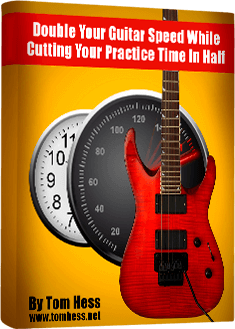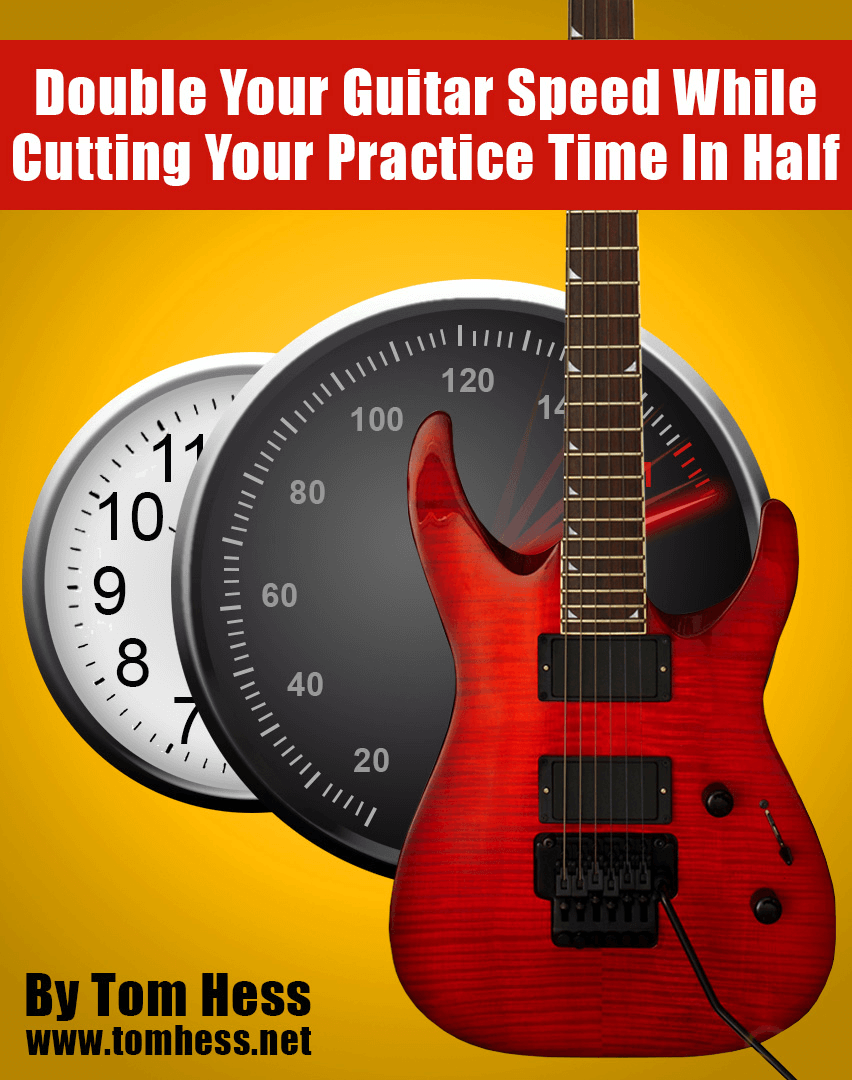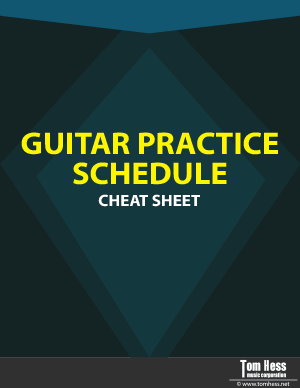Get More From Your Guitar Practice 8 Steps To Developing A Guitar Practice Schedule That Works
BY AT LEAST 100%

EMAIL TO GET ACCESS
By submitting your info, you agree to send it to Tom Hess Music Corporation who will process and use it according to their privacy policy.
If you are like most guitar players, you sometimes feel frustrated with your guitar playing. It may seem like a huge mountain to climb in order to reach very advanced levels of guitar playing you want.
One reason why so few people become great guitarists (even despite practicing guitar regularly) is because they don't know all the things they need to do or practice to reach their goals. You probably have more than enough things to practice (licks, techniques, exercises, scales etc.) but you may struggle with creating an overall plan to get the results you want.
A well-structured guitar practice regimen helps you take your guitar playing from where it is right now to where you want it to be. A guitar practice schedule that works helps you to: solve your guitar playing problems and develop the skills you need to play well.
Unfortunately, many guitarists believe many misconceptions about what having an efficient and effective guitar practice schedule really means... or what it means to practice guitar correctly.
BY AT LEAST 100%

EMAIL TO GET ACCESS
By submitting your info, you agree to send it to Tom Hess Music Corporation who will process and use it according to their privacy policy.
Some have tried to follow a guitar practice schedule for a while but either didn’t stick with it, or had an ineffective practice plan to start with.
Have you ever believed any of the following guitar practice myths?
Guitar Practice Myth #1: “Using a guitar practice schedule is boring.”
Guitar Practice Myth #2: “It's hard to stick with a guitar practice schedule when I practice guitar.”
Guitar Practice Myth #3: “Practice schedules are too rigid and they put limitations on your creativity.”
Guitar Practice Myth #4: “A guitar practice regimen is too structured and takes away freedom to drift to random things when playing or practicing guitar.”
Guitar Practice Myth #5: “Using a guitar practice schedule doesn't work. You can practice guitar (and make more progress) without one.”
Guitar Practice Myth #6: “It’s not fun to practice the same things in the same way each day.”

These statements describe bad (ineffective) practice routines. Truth is, bad practice routines DO SUCK!
However, an efficient, effective and flexible guitar practice schedule totally transform your guitar playing, musicianship and your creativity in a very short period of time. Want proof? Check out this free guitar technique & speed guide to see how easy it is to literally double your guitar speed while cutting your guitar practice time in half.
Imagine how much better your guitar playing life will be after you fully reached all of your musical goals!
A guitar practice schedule that works doesn’t hurt your creativity - they help you become a creative musician. In addition, your schedules can (and should) also include creative time to work on writing new songs, improvising, etc. How can it be boring to practice that which makes you a better guitar player and musician?
Yes, mindlessly practicing guitar using the same exercises every day is boring, which is why you shouldn’t design a guitar practice schedule in such a way. You want a structure that works, not one that drives you crazy.
You do NOT need to spend all your guitar practice time with a fixed schedule. For example, if you have 90 minutes to practice, invest 60-70 minutes working from your planned guitar practicing regimen. Use the rest of the time to freely play whatever you want.
The best routines are NOT the same each day. A guitar practice schedule should be effective, efficient and flexible.
A guitar practice schedule is a roadmap to playing whatever you want to play on guitar. But this doesn’t mean that you don’t have any room to have fun, be creative, and enjoy playing guitar in the process - you do. The only difference is that now you will be enjoying the process more and avoid mindlessly playing around without direction.
This means it will take you less time to become the excellent guitar player you want to be.
A guitar practice schedule that gets results is like a map. When you prepare to travel somewhere, you first analyze where you are (Point A), and then prepare the most direct and time-efficient route of arriving to your destination (Point B).
There are 8 steps to creating a guitar practice schedule. Download this guitar practice cheat sheet with all 8 steps to your computer now (it’s free and you don’t have to enter an email address). Then read the detailed description below to understand how to get the most from each step.
Step 1. Become very clear on what your LONG-TERM guitar playing / musical goals are. Beware of distractions… there is a big difference between short term goals and distractions. True short-term goals should be consistent with your long-term goals. If they aren’t, then you might be simply distracting yourself from what you really want to achieve as a guitar player and musician. When creating your guitar practice routine, focus mainly on long-term goals.
Step 2. Balance your existing strengths and RELEVANT weaknesses. Seek to turn your strengths into super strengths and only work on weaknesses that are truly relevant to your goals (see step 4 below).
Step 3. Be realistic about how much time you have for guitar practice each day. This means plan a little bit less time to practice than you think you will have available. For example: if you expect to have 1 hour to practice, plan to practice only 45-50 minutes.
Step 4. Be 100% sure you really know all the musical elements which are needed to reach your long-term goals. You also need to know which of these elements are primary versus secondary priorities for you to focus on right now.
Step 5. Always include creativity development into a guitar practice schedule (or work on it at least in your free time).
Contrary to popular belief, creativity CAN be taught, learned and practiced.
Step 6. Application is key! Plan time each day to work on applying your skills even if you have not mastered them yet! It's a big mistake to work only on mastering something before seeking to apply it.
Step 7. Don’t create the same schedule for each day of the week. Your schedules should span multiple days at a time. I use an 8-day guitar practice schedule system with my guitar students. This works much better than a routine that repeats itself each day. Some of the days can be the same, but other days are different (based on the previous steps).
Step 8. Create 3-5 different 8-day guitar practice regimens. Use each one twice (16 days) before working with the next one. Base every guitar practice schedule on the first 7 steps covered earlier.
Bonus tips to help you improve faster when you practice guitar:
Plan time for practicing guitar ‘away’ from the guitar.
You likely know you could do some things away from the guitar to make your playing better. Problem is: practicing away from the guitar happens at random for a lot of people.
(If it happens at all.)
But what if it wasn’t random?
What if you planned out your practice sessions away from your guitar the same exact way you plan your practice sessions with your guitar?
Like this:
Every Sunday (or whenever) think about your upcoming week.
Go through each day in your head and make a list of all the moments you expect to have some time.
Then plan the exact things you’ll do to make your playing better during that time. It could be reviewing your guitar lessons from your teacher.
Or practicing aural skills and music theory. Or visualizing your upcoming practice session at home.
Or thinking through a songwriting challenge. The possibilities are endless.
Don’t be hard on yourself if you miss one of those sessions. All of this is optional practice time anyway.
But if you can bring even a little bit of structure into how practice away from the guitar, it’s stunning how much more you get done during the week.
And since you’ll be thinking about practicing more often - your hands-on guitar practice becomes more productive too.
Next...
Take guitar lessons with a great teacher who can tell you exactly what to practice to reach your goals.
This not only makes it more likely that you’ll improve every time you practice guitar...
... it makes you more motivated ‘to’ practice (even on days when your guitar practice time is limited).
Here is just one example of how a great guitar teacher can help you improve faster:
Make guitar practice part of your identity.
This is a great way to motivate yourself to practice even on days when your practice time is limited. We all have non-negotiable activities in our day (taking a shower, checking our kids’ homework, walking the dog, exercising, etc.) There is no reason you couldn’t simply make ‘guitar practice’ one of those things. If you do, you’ll have a much easier time sticking to your guitar practice schedule and become a better guitar player much faster.
What’s next?
1. Get committed!
2. Stay committed! Follow through with your plan and watch your guitar playing get better and easier. If you find it hard to stay committed, focus on the reasons behind the goals you have set for yourself. Focus on how you will feel after you achieve them and are able to be, do and have what you want as a musician.
Want to get the very best guitar practice routine for playing guitar really, really fast? Download this free eGuide to learn how to double your guitar speed and learn to play as fast as you’ve always wanted.


Transform your guitar playing into totally freaking awesome, top-level guitar playing with the best online guitar lessons.




